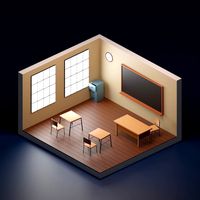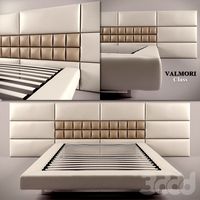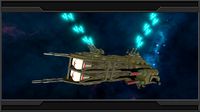Thingiverse

Morning Star Class Interplanetary Transporter by tommy99osullivan
by Thingiverse
Last crawled date: 3 years ago
This was my design for a realistic near term multirole spacecraft capable of fulfilling multiple mission parameters. The original necessities were to make a spacecraft that could fulfil all the original goals of the ISS (laboratory, observatory etc.) while at the same time mitigating bone density deterioration by creating artificial gravity for the crew, the ship also had to be deep space enabled and more affordable and lighter than the ISS.
The ship utilises inflatable modules from Bigelow aerospace called BA330s. These modules use over 35 layers of different fabrics, like kevlar that have improved ballistic protection from micrometeorites and also radiation over the traditional aluminium protection in the ISS. This is partially due to the fact that aluminium protection causes secondary radiation to be formed. An analogy to this would be to imagine that someone has thrown a bowling ball at you, so to protect yourself from the bowling ball, you decide to erect a wall of needles. Yes, you will stop the ball (or at least get rid of most of the bowling ball’s momentum) but now you have the needles to deal with. So imagine that the gamma radiation were to hit the aluminium atoms, the gamma ray may be stopped but now the crew are being blasted by secondary radiation, this is not the case to the same extent in the BA330.
For further radiation mitigation, the BA330s it will be using, will be lined with a further layer of water sealed into kevlar packs. Water has been proven as an effective radiation shield, particularly against small particle radiation and secondary radiation. The water will also be available for consumption. A number of tanks will be designated to holding the crew’s treated excrement, excrement is a valuable resource for water reclamation and also plant fertiliser.
It also has numerous other benefits, for example, the BA330 weighs in at between 20 and 25 tonnes, it has a pressurised volume of 330m3 (compare this to the ISS’s destiny module which weighs 15 tonnes and has an internal volume of around 106m3). These BA330s could be launched to space on a Falcon 9 and two could easily be launched on the proposed Falcon heavy.
Structural components of the ship such as the trusses are made of lightweight, yet very strong, materials like carbon fibre or titanium (to be replaced with lighter and stronger materials like graphene or carbon nanotubes when technological advancements are made). Inside the trusses, there is an inflatable cylindrical corridor that crew members can traverse to access the areas with artificial gravity from the central spin hub and central BA330.
Power is supplied to the ship by a SoLTeC (Solar Laser Transducer Craft) which flies alongside the ship and beams power over. I could upload the model for the SoLTeC at a later date.
The VASIMR engine is used on powered burns ranging from mere kilowatts all the way up to a megawatt thanks to the nearby SoLTeC satellite beaming over power. At first, the VASIMR is just used for station keeping and slow travel in cislunar space as the VASIMR technology is still in it’s infancy for the first few missions. Chemical rockets will be used to propel the ship around while it is on interplanetary missions or traveling to Lagrange or asteroidal destinations. Thanks to the ship’s modular configuration, the engines, habitation (hab) modules or other components can be removed if they are damaged or need to be upgraded. The engine would be the main component that would require constant upgrades as newer, more efficient and faster engines come into being.
On board the Morning Star however, the entire ship rotates (at 11 r.p.m.) so that the furthest outward point is travelling at a velocity of about 17.2m/s. This generates an acceleration of 9.8m/s2 (acceleration due to gravity on Earth). This force would be experienced while the ships crew were in the furthest out BA 330s. In these modules, the crew would sleep, eat and live while subjected to this Earth like acceleration. This acceleration, removes many problems associated with space travel that is experienced on the ISS. This includes bone density deterioration, which on some occasions proves so severe that astronauts are unable to walk when they return to Earth from space.
The model is quite large so I might upload some of the individual components in the future if there's enough interest.
The ship utilises inflatable modules from Bigelow aerospace called BA330s. These modules use over 35 layers of different fabrics, like kevlar that have improved ballistic protection from micrometeorites and also radiation over the traditional aluminium protection in the ISS. This is partially due to the fact that aluminium protection causes secondary radiation to be formed. An analogy to this would be to imagine that someone has thrown a bowling ball at you, so to protect yourself from the bowling ball, you decide to erect a wall of needles. Yes, you will stop the ball (or at least get rid of most of the bowling ball’s momentum) but now you have the needles to deal with. So imagine that the gamma radiation were to hit the aluminium atoms, the gamma ray may be stopped but now the crew are being blasted by secondary radiation, this is not the case to the same extent in the BA330.
For further radiation mitigation, the BA330s it will be using, will be lined with a further layer of water sealed into kevlar packs. Water has been proven as an effective radiation shield, particularly against small particle radiation and secondary radiation. The water will also be available for consumption. A number of tanks will be designated to holding the crew’s treated excrement, excrement is a valuable resource for water reclamation and also plant fertiliser.
It also has numerous other benefits, for example, the BA330 weighs in at between 20 and 25 tonnes, it has a pressurised volume of 330m3 (compare this to the ISS’s destiny module which weighs 15 tonnes and has an internal volume of around 106m3). These BA330s could be launched to space on a Falcon 9 and two could easily be launched on the proposed Falcon heavy.
Structural components of the ship such as the trusses are made of lightweight, yet very strong, materials like carbon fibre or titanium (to be replaced with lighter and stronger materials like graphene or carbon nanotubes when technological advancements are made). Inside the trusses, there is an inflatable cylindrical corridor that crew members can traverse to access the areas with artificial gravity from the central spin hub and central BA330.
Power is supplied to the ship by a SoLTeC (Solar Laser Transducer Craft) which flies alongside the ship and beams power over. I could upload the model for the SoLTeC at a later date.
The VASIMR engine is used on powered burns ranging from mere kilowatts all the way up to a megawatt thanks to the nearby SoLTeC satellite beaming over power. At first, the VASIMR is just used for station keeping and slow travel in cislunar space as the VASIMR technology is still in it’s infancy for the first few missions. Chemical rockets will be used to propel the ship around while it is on interplanetary missions or traveling to Lagrange or asteroidal destinations. Thanks to the ship’s modular configuration, the engines, habitation (hab) modules or other components can be removed if they are damaged or need to be upgraded. The engine would be the main component that would require constant upgrades as newer, more efficient and faster engines come into being.
On board the Morning Star however, the entire ship rotates (at 11 r.p.m.) so that the furthest outward point is travelling at a velocity of about 17.2m/s. This generates an acceleration of 9.8m/s2 (acceleration due to gravity on Earth). This force would be experienced while the ships crew were in the furthest out BA 330s. In these modules, the crew would sleep, eat and live while subjected to this Earth like acceleration. This acceleration, removes many problems associated with space travel that is experienced on the ISS. This includes bone density deterioration, which on some occasions proves so severe that astronauts are unable to walk when they return to Earth from space.
The model is quite large so I might upload some of the individual components in the future if there's enough interest.
Similar models
3dwarehouse
free

Interplanetary Space craft
... truss and two centrifugle modules at the front. #centrifuge #interplanetary #rocket #space #spacecraft #spaceship #truss #vasimr
cg_trader
$80

Near Future Interplanetary Space Ship
...into the blender file. technology steel exploration travel starcraft space spaceship planet realistic near future wheel habitable
thingiverse
free

Space craft for Deep space travel by sadben
...years. since nasa is planning another rover for mars in 2020, it can be estimated that there will be a manned mission around 2040
3dwarehouse
free

Japanese Experiment Module (JEM) (ISS)
...and final components were launched on sts-127. author/origin: nasa johnson space center http://www.nasa.gov/centers/johnson/home/
3dwarehouse
free

GoldenJet International Space Station Module {Artificial Gravity; 8Mb}
...n #animal #artificial #dynamics #goldenjet #gravity #international #module #on #space #station #testing #undocked #version #world
3dwarehouse
free

Traveller - Cavalier-class Ship's Boat
...cutter-class vessel. #boat #cutter #game #gig #pinnace #roleplaying #rpg #scifi #space #spaceship #starship #transport #traveller
3dwarehouse
free

174 Fuel Tugger
...gray section is the tugger vessel, the white is the cargo.) #fuel_tanks #slow_moving #space_ships_cargo #space_tanker #space_tugs
3dwarehouse
free

GoldenJet International Space Station Module WILL BE RE-UPLOADED WITH RENEWED REALISM.
...ion #animal #artificial #docked #dynamics #goldenjet #gravity #international #module #on #space #station #testing #version #world
3dwarehouse
free

BA Sundancer
...rehouse
bigelow aerospace sundancer inflatable space habitat module. #crew #iss #realistic #space_station #spacecraft #spaceship
grabcad
free

Space Craft for the Moon, Mars, and Beyond
...ears. since nasa is planning another rover for mars in 2020, it can be estimated that there will be a manned mission around 2040.
Tommy99Osullivan
thingiverse
free

Pachacuti Mk.1.1 FF Rocket Engine by tommy99osullivan
... there's also a lot of the designs as sheets there as well, which is helpful to demonstrate the inner workings of the engine.
thingiverse
free

Emissicius & Stradivarius Asteroid Survey Ship by tommy99osullivan
...s asteroids, these microphones can also be dropped as a huge net which is placed on the asteroid as opposed to this rover design.
Interplanetary
turbosquid
$19

Interplanetary Trasnport
...terplanetary trasnport for download as max, 3ds, fbx, and obj on turbosquid: 3d models for games, architecture, videos. (1627874)
turbosquid
$19

Interplanetary Transport
...terplanetary transport for download as max, 3ds, fbx, and obj on turbosquid: 3d models for games, architecture, videos. (1627868)
turbosquid
$10

interplanetary ship
... available on turbo squid, the world's leading provider of digital 3d models for visualization, films, television, and games.
cg_studio
$50

Interplanetary Explorer3d model
...lorer3d model
cgstudio
.max - interplanetary explorer 3d model, royalty free license available, instant download after purchase.
turbosquid
$120

Heavy Interplanetary Escort Shuttle
... available on turbo squid, the world's leading provider of digital 3d models for visualization, films, television, and games.
cg_studio
$50

Heavy Interplanetary Escort Shuttle3d model
...l .obj .fbx .dae - heavy interplanetary escort shuttle 3d model, royalty free license available, instant download after purchase.
3d_export
$55

Spaceship 3D Model
...model 3dexport space spaceship spacecraft sci-fi futuristic vehicle structure interplanetary base textures materials max obj 3ds fbx vray spaceship...
cg_studio
$55

Spaceship3d model
...space transport spaceship spacecraft sci fi futuristic vehicle structure interplanetary base textures materials max obj 3ds fbx vray .3ds...
cg_studio
$50

Scifi Passanger Freighter3d model
...cargo container space future ship rockets heavy vehicle transport interplanetary industrial work .stl .obj .fbx .dae .3ds - scifi...
cg_studio
$50

Heavy SciFi Cargo Freighter3d model
...cargo container space future ship rockets heavy vehicle transport interplanetary industrial work .stl .fbx .dae .3ds .obj - heavy...
Morning
3ddd
$1

morning dew
...morning dew
3ddd
morning dew
кресло morning dew дизайнер
turbosquid
$18

morning
... available on turbo squid, the world's leading provider of digital 3d models for visualization, films, television, and games.
3d_ocean
$6

Morning Star
...r chain knight low poly medieval morning star old weapon
model of an old weapon, the morning star. files included: .c4d .obj .3ds
3ddd
$1

Кожанная кровать Morning
...кожанная кровать morning
3ddd
morning
кожанная кровать morning
vray 1.5 материалы и текстуры присутствуют
design_connected
$7

Good Morning
... morning
designconnected
ligne roset good morning coffee tables computer generated 3d model. designed by alban-sebastien gilles.
3ddd
$1

AQUA / morning glory
...aqua / morning glory
3ddd
aqua creations
aqua / morning glory
3ddd
$1

Chesapeake / Sunday Morning
...chesapeake / sunday morning
3ddd
chesapeake
обои фабрики chesapeake
коллекция sunday morning
turbosquid
$20

Morning Star
... available on turbo squid, the world's leading provider of digital 3d models for visualization, films, television, and games.
turbosquid
$19

Morning Girl
... available on turbo squid, the world's leading provider of digital 3d models for visualization, films, television, and games.
turbosquid
$10

Morning coffe
... available on turbo squid, the world's leading provider of digital 3d models for visualization, films, television, and games.
Transporter
turbosquid
$2

Transportation
...quid
royalty free 3d model transportation for download as ma on turbosquid: 3d models for games, architecture, videos. (1393977)
turbosquid
$20

Transport
... available on turbo squid, the world's leading provider of digital 3d models for visualization, films, television, and games.
turbosquid
$3

transporter
... available on turbo squid, the world's leading provider of digital 3d models for visualization, films, television, and games.
turbosquid
free

transporter
... available on turbo squid, the world's leading provider of digital 3d models for visualization, films, television, and games.
turbosquid
free

Transporter
... available on turbo squid, the world's leading provider of digital 3d models for visualization, films, television, and games.
turbosquid
free

transport
... available on turbo squid, the world's leading provider of digital 3d models for visualization, films, television, and games.
3d_ocean
$12

bags transport
...bags transport
3docean
bags bags transport travel vacation
bags and trasport car
3d_export
$8

CubeMechine transport
...xport
cubemechine a transport machine with a cube shape and 4 joints, it comes with 4 textures included, ik in the blender scene
archive3d
free

Transport 3D Model
...ars
transport muti-troops n090316 - 3d model (*.gsm+*.3ds+*.max) for interior 3d visualization.
3d_export
$9

volkswagen transporter t2
...volkswagen transporter t2
3dexport
volkswagen transporter t2
Class
3d_export
free

Class room
...class room
3dexport
class room 3d model
3ddd
free

Capellini / Class
...capellini / class
3ddd
capellini
стул class фирмы capellini
3ddd
free

Valmori - Class
...valmori - class
3ddd
valmori
bed from valmori model class
3ddd
$1

LUCECREA CLASS
...lucecrea class
3ddd
lucecrea class
торшер фабрики lucecrea class_коллекция
bakara contract_art.376351 da a
turbosquid
$15

BaikaL class Frigate and UraL class Corvette
... available on turbo squid, the world's leading provider of digital 3d models for visualization, films, television, and games.
3ddd
$1

vibieffe class armchair
...vibieffe class armchair
3ddd
vibieffe
vibieffe class armchair
3ddd
$1

Baccarat Glass Class
...
источник:http://www.select-interiormarket.com/en/baccarat-glass-class-chair-2601025-philippe-starck
текстуры имеются
turbosquid
$85

Class Brooklyn
...alty free 3d model class brooklyn for download as jpg and max on turbosquid: 3d models for games, architecture, videos. (1461215)
3d_export
$5

class room
...class room
3dexport
turbosquid
$69

Mercedes Class
...d model mercedes class for download as 3ds, obj, c4d, and fbx on turbosquid: 3d models for games, architecture, videos. (1440493)
Star
3ddd
$1

Rolling Stars Antic Star
...rolling stars antic star
3ddd
rolling stars , вентилятор
rolling stars antic star
turbosquid
$2

Star Shuriken (Throwing Star)
... available on turbo squid, the world's leading provider of digital 3d models for visualization, films, television, and games.
design_connected
$18

Star
...star
designconnected
helen amy murray star computer generated 3d model. designed by murray, helen amy.
3d_ocean
$2

sea star
...sea star
3docean
game star sea star space star
this model is, normally poly model. use for games screen.
3d_export
$2

star gingerbread
...star gingerbread
3dexport
"star" gingerbread in the style of the movie star wars.
turbosquid
$10

STAR
...ar
turbosquid
royalty free 3d model star for download as max on turbosquid: 3d models for games, architecture, videos. (1338162)
turbosquid
$1

Star
...ar
turbosquid
royalty free 3d model star for download as c4d on turbosquid: 3d models for games, architecture, videos. (1564546)
3d_export
$5

star sword
...star sword
3dexport
star sword
3d_export
$5

Star building
...star building
3dexport
star building
3d_export
free

ikosaedr-star
...ikosaedr-star
3dexport
ikosaedr-star
